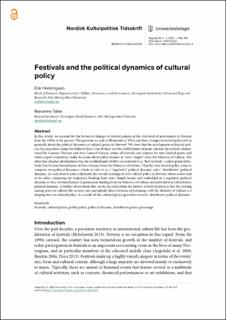Festivals and the political dynamics of cultural policy
Peer reviewed, Journal article
Published version
Permanent lenke
https://hdl.handle.net/11250/3113503Utgivelsesdato
2023Metadata
Vis full innførselSamlinger
- NIBR andre publikasjoner [31]
- NOVA andre dokumenter [95]
- Publikasjoner fra Cristin [3269]
Originalversjon
Nordisk kulturpolitisk tidsskrift. 2023, 26 (2), 146-160.Sammendrag
In this article, we account for the history of changes in festival policies at the state level of government in Norway from the 1990s to the present. The question we seek to illuminate is: What can these changes in festival policy tell us generally about the political dynamics of cultural policy in Norway? We show that the development of festival poli- cies has proceeded along two different lines. One of these was the establishment of grant schemes for festivals admini- stered by Concerts Norway and Arts Council Norway, where all festivals can compete for time-limited grants and where expert committees make decisions about public finance at “arm’s length” from the Ministry of Culture. The otherlineofpolicydevelopmentwastheestablishmentofwhatwasreferredtoas“hub-festivals”,aselectgroupoffes- tivals that became beneficiaries of direct finance from the Ministry of Culture. Thereby, state festival policy came to comprise two political dynamics, which we refer to as a “regulative” political dynamic and a “distributive” political dynamic. As such, festival policy illustrates the overall workings of state cultural policy in Norway, where actors tend to be either competing for temporary funding from arm’s length bodies and embedded in a regulative political dynamic or they are beneficiaries of permanent funding from the Ministry of Culture and embedded in a distributive political dynamic. A further observation that can be discerned from the history of festival policy is that the striving among actors in cultural life to enter into and uphold direct relations of patronage with the Ministry of Culture is a shaping force in cultural policy. As a result of this, cultural policy gravitates toward a distributive political dynamic.

